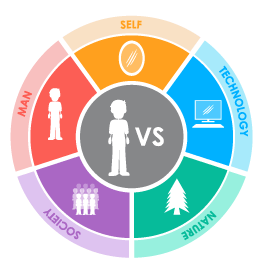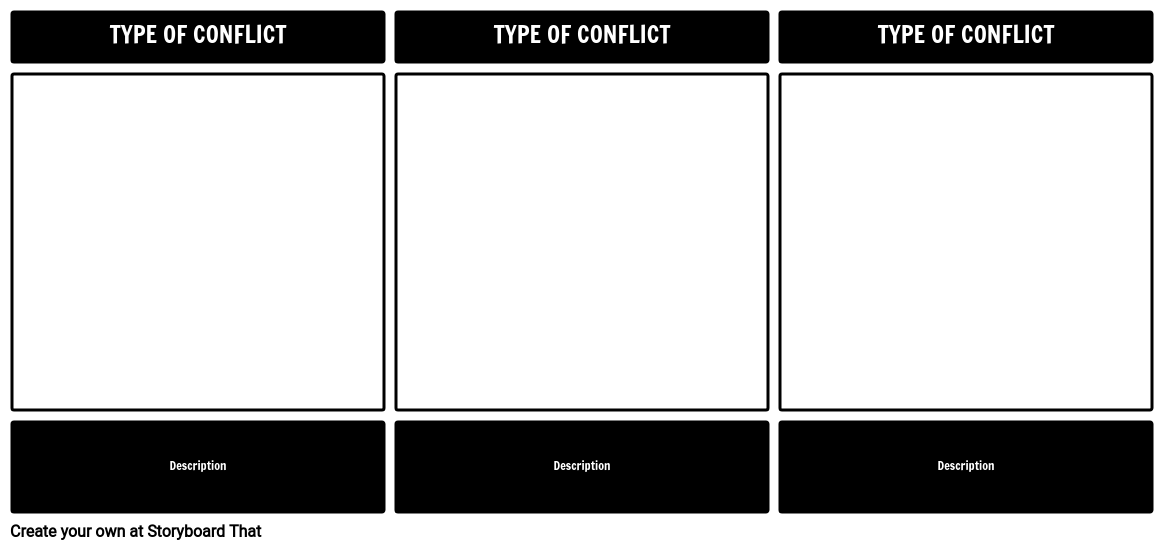Activity Overview
One of the things that make stories interesting and captivating enough for us to read and enjoy is conflict. Even if we don't want it in our own lives, without conflict, a story can be boring. It is what keeps us guessing at possible outcomes.
Man vs. Nature is the most prevalent in Hatchet. In this exercise, students should think of the different types of conflict and where they arise in the story. In addition to recreating the scene, students should include a description with an identification of the type of conflict and the impact it had on the plot.
An alternate activity would be to depict several instances of Brian vs. Nature in the same format as below. Recreate the scene with a description and show how Brian comes to handle these conflicts over time. How does Brian's attitude and actions change due to these conflicts?
Examples of Literary Conflict in Hatchet
MAN vs. NATURE
The pilot and Brian are helpless in the fight against nature when the pilot suffers a heart attack.
MAN vs. SELF
Brian doubts that he will survive alone in the woods. This is an internal conflict where his doubts threaten his survival.
MAN vs. MAN and MAN vs. SELF
When Brian realizes his mom is cheating on his dad, he has conflicting feelings toward both his mom and her "friend". He also has an internal conflict about keeping this awful "secret" to himself.
Template and Class Instructions
(These instructions are completely customizable. After clicking "Copy Activity", update the instructions on the Edit Tab of the assignment.)
Student Instructions
Create a storyboard that shows at least three forms of literary conflict in Hatchet.
- Identify three conflicts in Hatchet.
- Categorize each conflict as Character vs. Character, Character vs. Self, Character vs. Society, Character vs. Nature, or Character vs. Technology.
- Illustrate conflicts in the cells, using characters from the story.
- Write a short description of the conflict below the cell.
Lesson Plan Reference
- [ELA-Literacy/RL/8/1] Cite the textual evidence that most strongly supports an analysis of what the text says explicitly as well as inferences drawn from the text
- [ELA-Literacy/W/6/9] Draw evidence from literary or informational texts to support analysis, reflection, and research.
- [ELA-Literacy/W/7/1] Write arguments to support claims with clear reasons and relevant evidence.
Rubric
(You can also create your own on Quick Rubric.)
| Proficient | Emerging | Beginning | |
|---|---|---|---|
| Conflict Identification | Student identifies conflicts as directed and labels them accurately in their correct categories. | Student misidentifies one conflict or includes it in an incorrect category. | Student misidentifies two or more conflicts or includes them in incorrect categories. |
| Conflict Explanation | The storyboard text describes the specific example depicted, not just a general problem. The text clearly explains how the example reflects its particular type of conflict. | The storyboard text describes the specific example depicted, but may lack clarity. Text may fail to fully explain how the example reflects its particular type of conflict. | Storyboard is missing text or contains only partial and/or inaccurate information. |
| Storyboard Image and Effort | Student clearly shows effort to convey the setting, characters and specific scene of the book. The scene is clearly identifiable based on the graphic depiction. | Student attempts to convey the setting, characters, and specific scene through use of graphics, but the depiction may be confusing, disordered, or lack some detail. | Student does not clearly convey the setting, characters, and scene. |
| Spelling and Grammar | Student uses exemplary spelling and grammar. There are no errors. | Student makes one or two minor errors in spelling and grammar. | Student makes multiple errors in spelling and grammar. |
More Storyboard That Activities
Hatchet
© 2024 - Clever Prototypes, LLC - All rights reserved.
StoryboardThat is a trademark of Clever Prototypes, LLC, and Registered in U.S. Patent and Trademark Office










